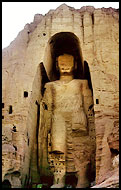
Mountainous Afghanistan has been a cross roads of Indo-Eurasian
trade and conquest since antiquity. Around 1500 BC Vedic Aryans,
initiators of Brahmanism, ruled the Northern Afghanistan. They were settled
in fertile plains of Bactria (Balkh). These Aryans were subjugated
by King Darius I of Persia who invaded Afghan area in 522 BC. In
330 BC Alexander the Great of Mecedonia vanquished Achaemenid emporer,
Darius III in Mesopotamia, marched his troops into Herat, Kandahar, Panjshair,
Bactria (Balkh), crossed Hindu Kush into Punjab (Pakistan) and Sindh (Pakistan).
After Alexander’s death, Afghanistan was divided between Greeks and Mouryans.
Famous among Mouryans was King Ashoka (268-233 BC). Rock inscriptions of
King Ashoka were found in both Greek and Aramaic languages in Laghman and
Kandahar. The Ashokan edicts encouraged piety and compassion towards
humans and animals.
The great Kushan King, Kanishka (130 AD), who originated from the Nomadic tribes of Central Asia that invaded Bactria, established an empire, which extended from Gobi desert to Ganges Valley. He promoted the richest trade of luxury goods ever in the world. Wines, ceramics and glass were shipped from imperial Rome and Alexandria, silks from China, spices and gems from South India. King Kanishka called a council of Buddhist scholars in Kashmir, which decided to humanize Buddhism in order to gain popularity over Brahmanism. This new school of Mahayana Buddhism placed more emphasis on the miraculous life and compassionate personality of Lord Buddha. It promised all worshippers universal salvation with the help of enlightened individuals called Bodhisatvas. This directly resulted in the artistic representation of the Buddha in human form for the first time. Buddhist art flourished under the Kushans and Buddhism swept across the Silk Route into China, Tibet and Far East. Except in far western parts, Buddhist sites are plentiful in Afghanistan. Stupas, the hemispherical domes, are the main attraction of these sites. The most famous of all Buddhist sites is Bamiyan. It has two colossal Buddha statues carved out of rockface about 1600 years ago. The large Buddha is about 180 ft and is the largest statue of its kind in the world.

In 1982, UNESCO considered four locations in Afghanistan to be included in their list of World Heritage Sites: Bamiyan, Herat, Jam and Ai Khanum, but no action was taken. In April 1997 a local Taliban leader said he would blow up the Bamiyan Buddhas. Due to international outrage, Taliban leader Mullah Muhammed Omar stated that the Bamiyan Buddhas would not be destroyed. However, it is reported recently that Ai Khanum was razed to the ground by bulldozers. Recently, Mullah Muhammed Omar has issued a new fatwa for the destruction of Pre Islamic culture and new wave of destruction began last week, without any regard to the international outrage.
The cultural heritage that is being destroyed is not just Brahmin or Buddhist or Hindu heritage; it is the heritage of the whole world. It is a pity that in this modern age the whole world is reduced to an impotent witness of the destruction of our cultural legacy by a destitute and backward state. The whole world will be impoverished forever due to this mindless and fanatical destruction.
Bibliography:
1) "A Brief History of Afghanistan," by Chris Bowers in "Essential
Field Guides to humanitarian Conflict Zones: Afghanistan," Ed. Edward Girardet
and Jonathan Walter.
2) Afghanistan, A Country Study, Ed. Richard F. Nyrop and Donald M. Seekins.
3) Over World Protests, Taliban Are Destroying Ancient Buddhas, By Barry Bearak, New York Times, March 4, 2001
4) U.N. Pleads With Taliban Not to Destroy Buddha Statues, New York Times, March 3, 2001.
Sreenivasarao Vepachedu, March 4, 2001